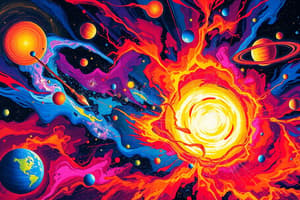Podcast
Questions and Answers
What phenomenon provides evidence for the expanding universe, indicating galaxies are moving away from us?
What phenomenon provides evidence for the expanding universe, indicating galaxies are moving away from us?
- Gravitational lensing
- Blue-shift
- Red-shift (correct)
- Stellar parallax
What term describes a collection of billions of stars held together by gravity?
What term describes a collection of billions of stars held together by gravity?
- Cluster
- Nebula
- Supernova
- Galaxy (correct)
What type of celestial structure is formed from clouds of gas and dust and is the birthplace of stars?
What type of celestial structure is formed from clouds of gas and dust and is the birthplace of stars?
- Star cluster
- Nebula (correct)
- Protostar
- Galaxy
What begins when the mass, temperature, and pressure in a protostar become high enough?
What begins when the mass, temperature, and pressure in a protostar become high enough?
How are stars classified?
How are stars classified?
What is the fate of a high mass star after it exhausts its nuclear fuel?
What is the fate of a high mass star after it exhausts its nuclear fuel?
What is the typical lifespan of a main sequence star that has more than 1.5 times the mass of the Sun?
What is the typical lifespan of a main sequence star that has more than 1.5 times the mass of the Sun?
As a star's temperature increases, what change occurs in its color?
As a star's temperature increases, what change occurs in its color?
What does the Big Bang Theory suggest about the origins of the Universe?
What does the Big Bang Theory suggest about the origins of the Universe?
Which evidence supports the idea that the Universe is expanding?
Which evidence supports the idea that the Universe is expanding?
What is the speed of all types of electromagnetic waves as they travel through space?
What is the speed of all types of electromagnetic waves as they travel through space?
How does frequency relate to wavelength in electromagnetic waves?
How does frequency relate to wavelength in electromagnetic waves?
What is the term used to describe the apparent shift in wavelengths of an electromagnetic wave due to the motion of the light source?
What is the term used to describe the apparent shift in wavelengths of an electromagnetic wave due to the motion of the light source?
When a light source moves towards an observer, what happens to the wavelengths of light?
When a light source moves towards an observer, what happens to the wavelengths of light?
What occurs to the wavelengths of light when a light source is moving away from an observer?
What occurs to the wavelengths of light when a light source is moving away from an observer?
What is the primary composition of atoms formed after the Big Bang?
What is the primary composition of atoms formed after the Big Bang?
Flashcards are hidden until you start studying
Study Notes
Origins of the Universe
- The Universe is all space, matter, and energy
- Universe is about 13.7 billion years old
- Big Bang Theory: All matter and energy in the Universe started concentrated in a small area, and after an explosion, matter began to organize into subatomic particles and atoms (mostly hydrogen and helium)
Our Universe is Expanding
- Continued to expand and is expanding today
- Evidence: Red-shift in spectra of galaxies and Cosmic Background Radiation coming from all directions in the Universe
Electromagnetic Energy
- Various types of waves transmitting energy through space
- All types travel at the speed of light, which is 3.0 x 10^8 m/s
Wavelength
- Distance between two successive crests or troughs
Frequency
- The number of waves that pass a certain point in a given period of time
- Frequency depends on wavelength: the longer the wavelength, the lower the frequency
The Doppler Effect
- Apparent shift in wavelengths of an electromagnetic wave
- When a light source is moving towards an observer, the shorter wavelengths of light appear blue - called blue-shift
- When a light source is moving away from an observer, the longer wavelengths of light appear red - called red-shift
Galaxy
- A collection of billions of stars and various amounts of gas and dust held together by gravity
- Categorized by shape
Our Milky Way Galaxy
- Spiral shaped and contains over 200 billion stars
Formation and Evolution of Stars
- Stars originate from clouds of gas and dust that swirl, condense and form balls of gases held together by gravity
- Stars form in huge celestial structures called nebulae
Formation and Evolution of Stars (continued)
- From a nebula comes a protostar (early star)
- Nebula is now spherical
- Mass, gravity, and temperature increase
- When the mass, temperature, and pressure get high enough, nuclear fusion begins - A STAR IS BORN!
- Tons of energy radiates out and travels through space as electromagnetic energy
Low & Medium Mass Stars
- Spend most of their lives as main sequence stars
- Further evolution depends on the star's mass
- Expand to red giant
- Burn all fuel, blow up, remaining core = white dwarf
- Example: our Sun
High Mass Stars
- Star remnants that are over 1.5 times the mass of our Sun exist for a shorter time (100,000,000 years) as main sequence stars
- Expand to red supergiant
- Explode as supernova
- High mass = neutron stars
- Very high mass star = black hole
Classification of Stars
- Stars are classified by their Luminosity (brightness) and Temperature
- As temperature increases, star color changes from red (cooler) to blue (hotter)
- 90% of all stars are categorized as main sequence stars
- Stars spend most of their “life” as main sequence stars.
Studying That Suits You
Use AI to generate personalized quizzes and flashcards to suit your learning preferences.




